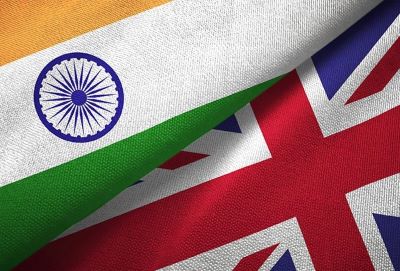Context-
The recent visit of Defence Minister Rajnath Singh to the United Kingdom (U.K.) after a 22-year gap signals a pivotal moment in India-U.K. defence relations. The geopolitical landscape has transformed significantly over the past two decades, presenting fresh opportunities for collaboration. The rise of Chinese military power, particularly its expansion into the Indian Ocean, poses a threat to both India and the U.K., creating a shared imperative to reevaluate their strategic priorities.
Opportunities and Challenges in India-U.K. Defence Ties
● The Indian Navy faces substantial capability challenges vis-à-vis the People's Liberation Army Navy (PLAN). Defence Minister Rajnath Singh's visit aimed at addressing these gaps, with a focus on securing key technologies. The U.K., recognizing the mutual benefits of collaboration, is well-positioned to assist in overcoming these technological shortcomings.
● One pivotal area of cooperation is electrical propulsion technology for aircraft carriers. The Indian Navy currently lacks this technology, while the Royal Navy's Queen Elizabeth Class aircraft carriers boast electric propulsion. This technology transfer becomes crucial in enhancing the Indian Navy's capabilities and maintaining strategic leverage in the region.
● The "India-UK electric propulsion capability partnership," established in February 2023, underscores the commitment to bridge the technological divide. Delegation-level discussions on HMS Lancaster in March furthered the dialogue on technical know-how transfer. The partnership reconvened in November 2023, with a commitment from the U.K. to train, equip, and facilitate infrastructure development for an electric propulsion system. Initial testing is expected on landing platform docks, progressing to next-generation surface vessels.
● The advantages of electric propulsion, including reduced acoustic signatures and enhanced electrical power generation, align with India's strategic goals. This partnership addresses the critical need for the Indian Navy to keep pace with evolving maritime technologies and counters potential advancements by the PLAN.
Strategic Realignment: Confronting the Chinese Challenge
● The rapid growth of Chinese naval power and its expanding presence in the Indian Ocean Region (IOR) provide a strong rationale for deepening defence ties between the U.K. and India. The emergence of the People's Republic of China (PRC) as a major naval power has necessitated joint military exercises and enhanced defence industrial cooperation. The British announcement of deploying a littoral response group in 2024 and a carrier strike group in 2025 underscores the commitment to increase interoperability with the Indian Navy.
● While historical complexities in U.K.-India ties persist, the evolving strategic realities, especially the Chinese threat, demand a reassessment of priorities. The U.K.'s historical balancing act between India and Pakistan has added complexity to diplomatic relations. However, the contemporary challenges posed by the PRC's naval expansion shift the focus towards collaborative efforts to secure common interests in the Indo-Pacific.
Overcoming Historical Complexities
● Addressing historical complexities in the India-U.K. defence relationship requires a nuanced approach. Successive U.K. governments have grappled with simultaneous arms supplies to India and Pakistan, reflecting the delicate diplomatic balance needed to maintain relationships with both countries. This historical baggage adds an additional layer of complexity to the evolving dynamics in the Subcontinent.
● The U.K.'s efforts to enhance its military presence East of Suez, rekindled during Rajnath Singh's visit, reflect a strategic recalibration. This move is reminiscent of London's historical military involvement in the region, which diminished significantly by the late 1960s. The re-emergence of the U.K.'s military engagement underscores a strategic alignment with India amid evolving geopolitical challenges.
● .The establishment of a joint working group for electric propulsion technology signifies a commitment to addressing India's naval capabilities' technological gaps. The U.K.'s willingness to share technical know-how and assist in infrastructure development reflects a pragmatic approach to foster a robust defence partnership.
Challenges: Navigating Legacy Issues
● While the evolving strategic landscape offers immense possibilities, navigating legacy issues remains a challenge. The U.K.'s historical ties with India and Pakistan, marked by arms supplies and restrictions, contribute to skepticism in India regarding British motives. The complexities surrounding Khalistan and Sikh separatism introduce additional sensitivities.
● However, the changing dynamics in the Indo-Pacific region, propelled by the PRC's naval expansion, demand a reassessment of priorities. The common threat perception arising from Chinese activities in the IOR provides a shared rationale for India and the U.K. to overcome historical complexities and forge a stronger defence partnership.
Conclusion
In conclusion, Defence Minister Rajnath Singh's recent visit to the U.K. signifies a paradigm shift in India-U.K. defence relations. The collaboration on electric propulsion technology, the announcement of deployment plans, and joint military exercises underscore the shared commitment to address common security challenges, particularly in light of the Chinese threat.
While historical complexities and legacy issues pose challenges, the evolving strategic realities necessitate a recalibration of priorities. The U.K.'s re-engagement East of Suez, coupled with India's pursuit of advanced military capabilities, creates a conducive environment for a comprehensive and enduring defence partnership. The coming together of India and the U.K. in the face of emerging geopolitical challenges marks the crafting of a new phase in their defence ties.
|
Probable Questions for UPSC Mains Exam- 1.What key technological gap in the Indian Navy is the focus of the collaboration between India and the U.K., as highlighted during Defence Minister Rajnath Singh's recent visit, and how does the partnership address this deficiency? (10 Marks, 150 Words) 2.How do historical complexities, particularly the U.K.'s historical balancing act between India and Pakistan, contribute to challenges in the India-U.K. defence relationship, and how are contemporary geopolitical realities, especially the rise of the People's Republic of China, influencing a reassessment of priorities in their strategic alignment?.(15 Marks, 250 Words) |
Source- The Hindu







